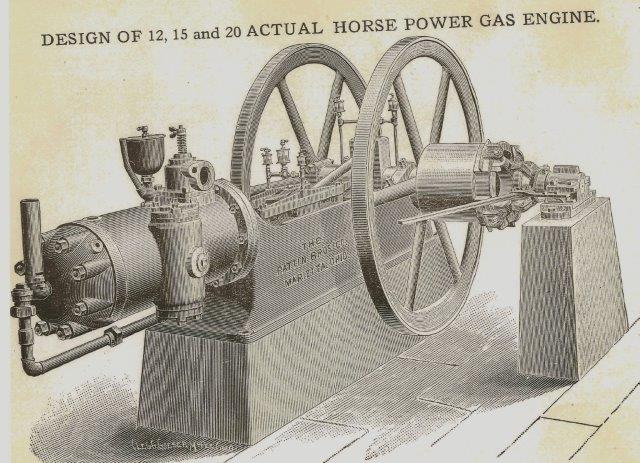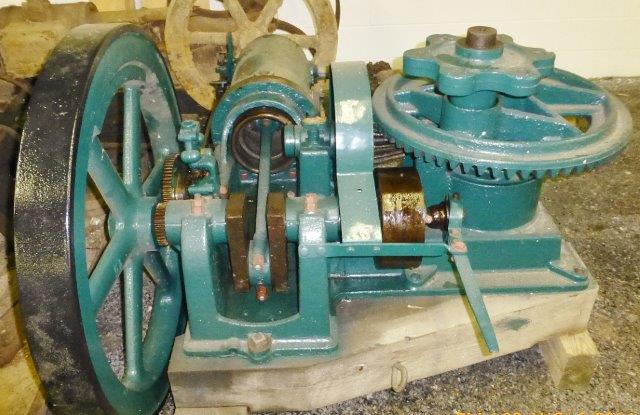|

September 2014
Pattin Brothers: Ohio's Oil Field
Engine
By
Paul Harvey
Lt. Col. Thomas Jefferson Pattin fought gallantly in the
Civil War as a leader of the Ohio First Cavalry. After the war, he
returned home to his wife and family who waited in
Marietta, Ohio, and soon
became listed as a master mechanic. A bustling river town,
Marietta was growing, being transformed from an
agricultural hamlet into an industrial city. Oil had already been found
at Titusville, Pennsylvania,
and the boom was marching south. Soon Marietta
would be a hub of the new trade - oil field equipment! And so our story
starts...
Lt. Col. Pattin had four children, three sons born before the war and one
daughter after. Two of the sons, Winfield and Douglas, shared his
mechanical aptitude and joined with J. G. Hall in 1888 to form Pattin,
Hall, and Pattin. They built a machine shop in the west side of the
city. In 1895, The Pattins purchased Mr. Hall's interests and formed
Pattin Bros. & Co., building a new plant on
Second Street. Business was good so they
continued the original works as well, employing about 50 men at this
time. The new firm grew as shown by the 1907 letterhead in Photo
1.
Winfield Scott Pattin was born in 1851 and attended
Marietta College
in the early 1870s. He was listed as a machinist in 1873, then moved
to Scott County, Missouri, in 1875 where he married Cecelia Cullum.
They moved back to Marietta
in 1880. Ironically, he died of pneumonia on a business trip to the
West Virginia oil fields on March 27, 1913. His younger brother, Douglas P.
Pattin, was born in 1859 and spent his life in
Marietta. He was also a machinist and deeply
involved with the new firm. On the morning of October 20, 1901, Douglas and two other persons
visited the big plant on Second Street.
Having done what was needed, he left his companions to investigate the
strong odor of natural gas. Moments later, as his friends were walking
away, a huge explosion occurred and the plant was immediately engulfed
in flames. His remains were found that evening. According to the
Marietta Register, the firm of Pattin Brothers rebuilt and grew
stronger.
Both Pattin Brothers shared only one patent together, which is shown as
Photo 2. Granted on February 16, 1892, number
469,173, it
concerns the operating valve for a steam engine.
Marietta was now in the midst of the oil boom and
needed steam engines to both drill the wells and then pump them. The
steam engine became one of their major products. Pattin Brothers also
built all kinds of oil field tooling and equipment.
The gas engine patent did not occur until after Douglas's
death. It is shared by W. S. Pattin and W. F. Meister. A combined
governor, included in the gas and air mixer, was patented on
May 26, 1903. Number
729,377 is shown as Photo 3.
There has never been a similar device that worked so well. A drawing
of the original engine is seen in Photo 4, and an existing
example in a Parkersburg,
West Virginia, collection is seen in Photo
5. This indicates that the original design was two-cycle and
shares many features that were seen in later engines. Note the cylinder
oiler with the air vent and the engine's long, narrow lines. The four-cycle engines bearing the EKONOMY name came later.
Photo 6, taken from an undated photo, briefly explains
the "Automatic Governor." The intake valve, which admits the fuel gas
through holes in its tapered seat, also carries a cylinder valve with
circular openings for both the air and gas. As the engine speed
increases so does the stroke of the intake valve. This lowers the
cylinder valve which reduces the amount of air and gas available. And
so the engine slows and returns to regular operation. Close examination
of the patent drawing, Photo 3, will show the
position of the valves. Engine speed can be controlled by tightening or
loosening the nut on the intake valve. Very ingenious!!
William Meister began working for Pattin Brothers on
January 12, 1891, as an apprentice. Two years later, he
moved into the foreman position and from that time had an ever
increasingly responsible role in all the company's developments. He
held the patents for the Pattin Brothers combination engine and power,
and the MEISTER feather valves used on later compressors, as well as
several others. After Winfield's death, he became president and general
manager. In the mid-1940s, Pattin Brothers was purchased by Acme
Fishing Tool Co. of Parkersburg, West Virginia.
Acme president, L. M. Ludlow, said that all the operations of Pattin
Brothers would remain the same, including Mr. Meister as general
manager. And so the name lived on for many more years.
Pattin Brothers products were diverse but all were oriented to the oil
fields and its needs. Most of the equipment was used in the local area,
although they had a major distributor in Bradford,
Pennsylvania. Photo 7 shows a
belt driven Pattin Brothers pumping power. This is located in the yard
of the
Oil and Gas
Museum located in
Parkersburg, West Virginia.
Containing a huge array of local oil field artifacts and equipment, this
museum is certainly a delight to visit. While attending the "By the
Lake" show near Harrisville, West Virginia, I spotted this 4 1/2 hp
Pattin-United combined engine and pumping power. See Photo 8.
Note the horizontal hot tube and chimney which is the original
location. I am unsure of the connection of Pattin and United but these
engines were used on several of Pattin Brothers products. The name
plate on this engine states "manufactured by Pattin Brothers." Oddly,
Pattin Brothers did build a five horsepower engine. Photo 9
depicts a four-cycle engine with opposed compressor cylinders.
Taken from a 1920 catalog, these units were built in 40, 50, 60 and 90
hp sizes. A 40 hp example will be arriving in Coolspring this autumn!
The 1920 catalog also shows a vast array of belt driven pumps as seen
in Photo 10.
Photo 11, taken from the same 1920 catalog, shows a small
engine and pump combination. Again, it is unclear if these small units
were built by Pattin Brothers or assembled from items made by others.
The largest engine built by Pattin Brothers was the 100 hp "Super Power"
engine compressor unit. A 1925 catalog shows this unit; Photo
12. These huge units were four-cycle with over and under intake
and exhaust valves. Being ported and having a side shaft, they employed
a rotary valve to close the exhaust port in the intake stroke. This
feature is
unique to the Super Power. Opposed to the engine cylinder are twin, two
stage compressor cylinders, one mounted above the crankshaft and the
other below. History relates that only three were built and one still
survives at its original location. Photo 13 shows an old
photo of the (apparently) late design, 40 hp fully enclosed model. This
photo was found in the Oil and Gas
Museum archives. Note that they have
reverted to the two-cycle design, as the original was.
Coolspring
Power Museum
is proud to display seven Pattin Brothers engines. Photo 14
shows a 25 hp four-cycle model. Having pumped an oil lease in southeastern Ohio, this model
is hit and miss governed by a nicely done vertical governor, which
disables the gas valve. It has both hot tube and high bar KW magneto
ignition and a ported cylinder. Note the location of the flywheel
counterweights! A 20 hp combination engine and power is shown in
Photo 15. It is four-cycle, hit and miss, and sports the
EKONOMY name plate. Originally located in Dallas Hollow near
Bradford, Pennsylvania, it
came to Coolspring in 1969. Photo 16 shows a 15 hp four-cycle Pattin Brothers engine that has a pendulum governor. According to
a vintage catalog, the smaller models, 12, 15 and 20 hp, had the
pendulum governor and the large ones, 25 to 90 hp, had the vertical
governor. As with the 25 hp model, this one is hit and miss with the
governor operating the fuel valve. It pumped an oil lease near
Wingett Run, Ohio, and has
been in Coolspring since 1970. A 15 hp, two-cycle model is shown in
Photo 17. It retains the lines of the original model but
does not have the automatic intake valve governor. It was found in
northeastern Pennsylvania.
Photo 18 is a 12 hp two-cycle engine with attached pump.
Found near Marienville,
Pennsylvania, it does not have the back gear
with the pump crank mounted on it at this time. It was ideal to pump a
small oil lease and equipped to then transfer the oil to the nearest
National Transit pipeline station. Unique idea! A small brother to our
20 hp combination engine and pumping power is this 8 hp unit as shown in
Photo 19. It also came from Wingett
Run, Ohio, many years
ago. The local oil producer greatly preferred these small Pattin
Brothers units over the Kootz & Strohman and Spence units for
dependability. It interesting to note that an enthusiast has imported
one of these 8 hp combination units to
New Zealand! Photo 20
shows the 8 hp engine, which is similar to the 8 hp combination, being
operated at one of our shows. Found near Marietta
in 1969, it was belted to a small Pattin Brothers power to pump one
well. A 5 hp model of this engine was also produced and several
examples still survive.
Please visit Coolspring
Power Museum
for our Fall Show & Swap Meet held on October 16, 17, & 18, 2014.
Several of the Pattin Brothers engines will be in operation. This
will be our last event for 2014. Special tours can be arranged by
advanced appointment during the winter. Next year will be our 30th
anniversary show, The Flame Ignition Expo! It promises to be the
largest assembly of flame ignition and slide valve engines ever.
Keep in touch by watching our web site
www.coolspringpowermuseum.org or calling 814-849-6883. See you
then!
|




















